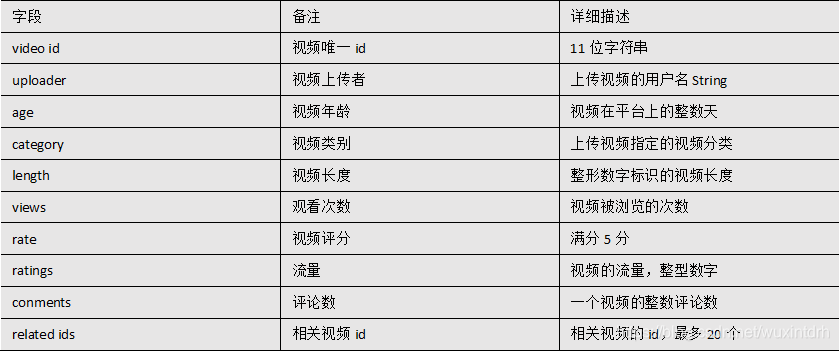文章目录
- 一、需求
- 二、数据结构
- 三、准备工作
- 四、业务分析
- 4.1、统计视频观看数Top10
- 4.2、统计视频类别热度Top10
- 4.3、统计出视频观看数最高的20个视频的所属类别以及类别包含Top20视频的个数
- 4.4、统计视频观看数Top50所关联视频的所属类别Rank
- 4.4.1、查询出观看数最多的前50个视频的所有信息(当然包含了每个视频对应的关联视频),记为临时表t1
- 4.4.2、将找到的50条视频信息的相关视频relatedId列转行,记为临时表t2
- 4.4.3、将相关视频的id和chbvideo_orc表进行inner join操作
- 4.4.4、按照视频类别进行分组,统计每组视频个数,然后排行
- 4.5、统计每个类别中的视频热度Top10,以Music为例
- 4.6、统计每个类别中视频流量Top10,以Music为例
- 4.7、统计上传视频最多的用户Top10以及他们上传的观看次数在前20的视频
- 4.8、统计每个类别视频观看数Top10
一、需求
需求描述
统计视频网站的常规指标,各种TopN指标:
- 统计视频观看数Top10
- 统计视频类别热度Top10
- 统计视频观看数Top20所属类别
- 统计视频观看数Top50所关联视频的所属类别Rank
- 统计每个类别中的视频热度Top10
- 统计每个类别中视频流量Top10
- 统计上传视频最多的用户Top10以及他们上传的视频
- 统计每个类别视频观看数Top10
二、数据结构
2.1、视频表

2.2、用户表

2.3、测试数据
三、准备工作
3.1、创建表
创建表:chbvideo_ori,chbvideo_user_ori,
创建表:chbvideo_orc,chbvideo_user_orc
3.1.1、chbvideo_ori
create table chbvideo_ori(
videoId string,
uploader string,
age int,
category array<string>,
length int,
views int,
rate float,
ratings int,
comments int,
relatedId array<string>)
row format delimited
fields terminated by "\t"
collection items terminated by "&"
stored as textfile;
3.1.2、chbvideo_user_ori
create table chbvideo_user_ori(
uploader string,
videos int,
friends int)
row format delimited
fields terminated by "\t"
stored as textfile;
3.1.3、导入数据
load data inpath '/tmp/hivetest/chbVideoOut/video/2008/0222' overwrite into table chbvideo_ori;
load data local inpath '/uardata1/hivetest/chbVideo/user/2008/0903' into table chbvideo_user_ori;
3.1.4、导入到orc表中
create table chbvideo_orc(
videoId string,
uploader string,
age int,
category array<string>,
length int,
views int,
rate float,
ratings int,
comments int,
relatedId array<string>)
clustered by (uploader) into 8 buckets
row format delimited fields terminated by "\t"
collection items terminated by "&"
stored as orc;
create table chbvideo_user_orc(
uploader string,
videos int,
friends int)
row format delimited
fields terminated by "\t"
stored as orc;
# 导入到表中
chbvideo_orc:
insert into table chbvideo_orc select * from chbvideo_ori;
chbvideo_user_orc:
insert into table chbvideo_user_orc select * from chbvideo_user_ori;
四、业务分析
4.1、统计视频观看数Top10
思路:使用order by按照views字段做一个全局排序即可,同时我们设置只显示前10条。
select
videoId,
uploader,
age,
category,
length,
views,
rate,
ratings,
comments
from chbvideo_orc
order by views desc
limit 10;
4.2、统计视频类别热度Top10
思路:
- 1、即统计每个类别有多少个视频,显示出包含视频最多的前10个类别。
- 2、我们需要按照类别group by聚合,然后count组内的videoId个数即可。
- 3、因为当前表结构为:一个视频对应一个或多个类别。所以如果要group by类别,需要先将类别进行列转行(展开),然后再进行count即可。
- 4)、最后按照热度排序,显示前10条。
select
category_name as category,
count(t1.videoId) as hot
from (
select
videoId,
category_name
from
chbvideo_orc lateral view explode(category) t_catetory as category_name) t1
group by t1.category_name
order by hot desc
limit 10;
4.3、统计出视频观看数最高的20个视频的所属类别以及类别包含Top20视频的个数
思路:
- 1、 先找到观看数最高的20个视频所属条目的所有信息,降序排列
- 2、把这20条信息中的category分裂出来(列转行)
- 3、 最后查询视频分类名称和该分类下有多少个Top20的视频
select
category_name as category,
count(t2.videoId) as hot_with_views
from (
select
videoId,
category_name
from (
select
*
from
chbvideo_orc
order by views desc
limit 20
) t1 lateral view explode(category) t_catetory as category_name) t2
group by category_name
order by hot_with_views desc;
4.4、统计视频观看数Top50所关联视频的所属类别Rank
思路
4.4.1、查询出观看数最多的前50个视频的所有信息(当然包含了每个视频对应的关联视频),记为临时表t1
t1:观看数前50的视频
select
*
from
chbvideo_orc
order by views desc
limit 50;
4.4.2、将找到的50条视频信息的相关视频relatedId列转行,记为临时表t2
t2:将相关视频的id进行列转行操作
select
explode(relatedId) as videoId
from
t1;
4.4.3、将相关视频的id和chbvideo_orc表进行inner join操作
t5:得到两列数据,一列是category,一列是之前查询出来的相关视频id
(select
distinct(t2.videoId),
t3.category
from
t2
inner join
chbvideo_orc t3 on t2.videoId = t3.videoId) t4 lateral view explode(category) t_catetory as category_name;
4.4.4、按照视频类别进行分组,统计每组视频个数,然后排行
select
category_name as category,
count(t5.videoId) as hot
from (
select
videoId,
category_name
from (
select
distinct(t2.videoId),
t3.category
from (
select
explode(relatedId) as videoId
from (
select
*
from
chbvideo_orc
order by views desc
limit 50
) t1
) t2
inner join
chbvideo_orc t3 on t2.videoId = t3.videoId) t4 lateral view explode(category) t_catetory as category_name) t5
group by category_name
order by hot desc;
4.5、统计每个类别中的视频热度Top10,以Music为例
4.5.1、思路:
- 要想统计Music类别中的视频热度Top10,需要先找到Music类别,那么就需要将category展开,所以可以创建一张表用于存放categoryId展开的数据。
- 向category展开的表中插入数据。
- 统计对应类别(Music)中的视频热度。
4.5.2、创建表类别表:
create table chbvideo_category(
videoId string,
uploader string,
age int,
categoryId string,
length int,
views int,
rate float,
ratings int,
comments int,
relatedId array<string>)
row format delimited
fields terminated by "\t"
collection items terminated by "&"
stored as orc;
4.5.3、向类别表中插入数据:
insert into table chbvideo_category
select
videoId,
uploader,
age,
categoryId,
length,
views,
rate,
ratings,
comments,
relatedId
from
chbvideo_orc lateral view explode(category) catetory as categoryId;
4.5.4、统计Music类别的Top10(也可以统计其他)
select
videoId,
views
from
chbvideo_category
where
categoryId = "Music"
order by views desc
limit 10;
4.6、统计每个类别中视频流量Top10,以Music为例
思路:
- 1、创建视频类别展开表(categoryId列转行后的表)
- 2、按照ratings排序即可
select
videoId,
views,
ratings
from
chbvideo_category
where
categoryId = "Music"
order by ratings desc
limit 10;
4.7、统计上传视频最多的用户Top10以及他们上传的观看次数在前20的视频
思路:
4.7.1、先找到上传视频最多的10个用户的用户信息
select
*
from
chbvideo_user_orc
order by videos desc
limit 10;
4.7.2、通过uploader字段与chbvideo_orc表进行join,得到的信息按照views观看次数进行排序即可。
select
t2.videoId,
t2.views,
t2.ratings,
t1.videos,
t1.friends
from (
select
*
from
chbvideo_user_orc
order by videos desc
limit 10
) t1
join
chbvideo_orc t2
on
t1.uploader = t2.uploader
order by views desc
limit 20;
4.8、统计每个类别视频观看数Top10
思路:
- 先得到categoryId展开的表数据
- 子查询按照categoryId进行分区,然后分区内排序,并生成递增数字,该递增数字这一列起名为rank列
- 通过子查询产生的临时表,查询rank值小于等于10的数据行即可。
select
t1.*
from (
select
videoId,
categoryId,
views,
row_number() over(partition by categoryId order by views desc) rank from chbvideo_category) t1
where
rank <= 10;